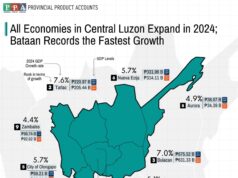Summarizing his conversations with innumerable foresters while attending international forestry conferences in India and Portugal, Jack Westoby observed: “Had I believed implicitly everything they told me, I would have been driven to the conclusion that forestry is about trees. But this, of course, is quite wrong. Forestry is not about trees, it is about people. And it is about trees only insofar as they serve the needs of people.”
And this was what the book, Forestry Faces: Hopes and Regrets in Philippine Forestry, is all about. The 250-page book, with 53 profiles of people who were directly involved in the country’s forest resources, was published jointly by the regional office of the UN Food and Agriculture Organization (FAO) and the Environmental Science for Social Change (ESSC) of the Ateneo de Manila University.
“As much as we might idealize the connection between people and forests, the reality is that not all embrace the value and indispensability of trees and forests,” wrote FAO assistant director general He Changchui in his foreword of the book. “Underlying the story… are current of regrets for what has gone before and cautionary notes for what may yet be to come.”
The Philippines is now devoid of its forest cover. Of the country’s total forestland area of 15.88 million hectares, only 5.4 million hectares are covered with forests and fewer than a million hectares are left with old growth forests.
“No one says there is an increase in real forest cover in the Philippines. Maybe there is an increase in the number of trees, but it is not the forest we idealize, romanticize, log or even live in,” says Peter Walpole, ESCC executive director. “We have lost most of our forest of hold over the past 50 years and, along with them, many of the ecological services they provide.”
It is said that stories are a primary means through which we gain understanding. And each of the people featured in the book has a story to tell and different views to share about trees and forests. Victor O. Ramos, who grew up in northern Pangasinan, had always associated forests with people who were happy. Then, it was not until he became the head of the Department of Environment and Natural Resources (DENR) that he came face to face with reality. “I have never seen, until I came to DENR, and never expected that forests would just be there as trees without people.”
“The way I look at the Philippine environment, forest and people today is that we really have a very damaged ecosystem,” notes Delfin Ganapin, Jr., the global manager of the Global Environment Fund of the United Nations Development Program. “In fact, when I started doing forestry work, there was already quite significant damage in our forests. And that gets you to start thinking what are the roots of the problem?”
“If we care less for the forest, we will not live without the forest,” says Dante Sinhayan, a tribal leader in the uplands of Bukidnon in Mindanao. “I cannot live without the forest. Without the forest, I feel different in the city seeing big buildings. It is too hot. In the forest, it is cool, and I hear the sounds of different birds.”
“Deforestation is a symptom of a bigger problem,” says Nicolo del Castillo, an architect by profession who teaches at the University of the Philippines. “I probably sound baduy (tacky and outdated) but I see the problem in the prevailing system of values, that is, the greed, the need to be the biggest, the wealthiest, and sometimes you feel hopeless. I am an optimist, but possibly there will be more tragedies and maybe then more people will wake up.”
Jo-Anne Legaspi is a young lawyer who works in Makati City, the country’s primary financial hub. “There are no such things as forests in Makati,” she says. “I think in the provinces, forests can be found, but are facing the usual problems of deforestation, illegal mines, etc.”
Speaking of mines, Ed Coronel, who carves out his career in the Philippine mining industry, has this share: “I am tormented by forests. I hold a romantic view of forests, but at the same time also a pragmatic view, that forests are a collateral damage to progress, just like other things in society.”
Mount Banahaw in Dolores, Quezon is the most intimate place for musician/songwriter Jose “Joey” Ayala. He said that it offers him a venue where he could reach and transcend a different state of being while inside its forests. “We must find a space for the forestal spirit, so that the spirit nature of man will survive accordingly with nature, with capitalism, with the drive for efficiency,” he points out.
Anabelle Plantilla, the executive director of the Haribon Foundation, first became aware of forests in 1987 when she saw the photo of the Philippine eagle in a newspaper. “I fell in love with the beautiful bird and I started reading up about the eagle. The image of the eagle persists strongly in her mind and in her current work, as the image is what links her to the forest. “I saw the forest from the eagle’s perspective, then I saw the area connection, that this much area is needed for a single bird.”
“Establishing forests is kinda sentimental for me,” says Patrick Dugan, an agroforstry specialist. “I am just stunned by the appreciation of what’s there, God’s creation. Look, we’re a hilly country, and what grows best here? Trees!”
Here’s a thought from Ben Malayang III, president of Silliman State University: “That the forest, the foundations of our forests, or whatever forests remain in the country, is not a matter of technical forestry, but rather a symptom, or an indication, or a measure, of the failure of our political and social systems.”
Children have their own voices, too. “When I was still a child, my father took part in logging activities and we had more than enough money,” recalls Roldan Sagula, an elementary student at the Apu Palamguwan Cultural Education Center. “But when logging stopped, father lost his job as well and we ended up losing so many of the trees as well.”
And this was what the book, Forestry Faces: Hopes and Regrets in Philippine Forestry, is all about. The 250-page book, with 53 profiles of people who were directly involved in the country’s forest resources, was published jointly by the regional office of the UN Food and Agriculture Organization (FAO) and the Environmental Science for Social Change (ESSC) of the Ateneo de Manila University.
“As much as we might idealize the connection between people and forests, the reality is that not all embrace the value and indispensability of trees and forests,” wrote FAO assistant director general He Changchui in his foreword of the book. “Underlying the story… are current of regrets for what has gone before and cautionary notes for what may yet be to come.”
The Philippines is now devoid of its forest cover. Of the country’s total forestland area of 15.88 million hectares, only 5.4 million hectares are covered with forests and fewer than a million hectares are left with old growth forests.
“No one says there is an increase in real forest cover in the Philippines. Maybe there is an increase in the number of trees, but it is not the forest we idealize, romanticize, log or even live in,” says Peter Walpole, ESCC executive director. “We have lost most of our forest of hold over the past 50 years and, along with them, many of the ecological services they provide.”
It is said that stories are a primary means through which we gain understanding. And each of the people featured in the book has a story to tell and different views to share about trees and forests. Victor O. Ramos, who grew up in northern Pangasinan, had always associated forests with people who were happy. Then, it was not until he became the head of the Department of Environment and Natural Resources (DENR) that he came face to face with reality. “I have never seen, until I came to DENR, and never expected that forests would just be there as trees without people.”
“The way I look at the Philippine environment, forest and people today is that we really have a very damaged ecosystem,” notes Delfin Ganapin, Jr., the global manager of the Global Environment Fund of the United Nations Development Program. “In fact, when I started doing forestry work, there was already quite significant damage in our forests. And that gets you to start thinking what are the roots of the problem?”
“If we care less for the forest, we will not live without the forest,” says Dante Sinhayan, a tribal leader in the uplands of Bukidnon in Mindanao. “I cannot live without the forest. Without the forest, I feel different in the city seeing big buildings. It is too hot. In the forest, it is cool, and I hear the sounds of different birds.”
“Deforestation is a symptom of a bigger problem,” says Nicolo del Castillo, an architect by profession who teaches at the University of the Philippines. “I probably sound baduy (tacky and outdated) but I see the problem in the prevailing system of values, that is, the greed, the need to be the biggest, the wealthiest, and sometimes you feel hopeless. I am an optimist, but possibly there will be more tragedies and maybe then more people will wake up.”
Jo-Anne Legaspi is a young lawyer who works in Makati City, the country’s primary financial hub. “There are no such things as forests in Makati,” she says. “I think in the provinces, forests can be found, but are facing the usual problems of deforestation, illegal mines, etc.”
Speaking of mines, Ed Coronel, who carves out his career in the Philippine mining industry, has this share: “I am tormented by forests. I hold a romantic view of forests, but at the same time also a pragmatic view, that forests are a collateral damage to progress, just like other things in society.”
Mount Banahaw in Dolores, Quezon is the most intimate place for musician/songwriter Jose “Joey” Ayala. He said that it offers him a venue where he could reach and transcend a different state of being while inside its forests. “We must find a space for the forestal spirit, so that the spirit nature of man will survive accordingly with nature, with capitalism, with the drive for efficiency,” he points out.
Anabelle Plantilla, the executive director of the Haribon Foundation, first became aware of forests in 1987 when she saw the photo of the Philippine eagle in a newspaper. “I fell in love with the beautiful bird and I started reading up about the eagle. The image of the eagle persists strongly in her mind and in her current work, as the image is what links her to the forest. “I saw the forest from the eagle’s perspective, then I saw the area connection, that this much area is needed for a single bird.”
“Establishing forests is kinda sentimental for me,” says Patrick Dugan, an agroforstry specialist. “I am just stunned by the appreciation of what’s there, God’s creation. Look, we’re a hilly country, and what grows best here? Trees!”
Here’s a thought from Ben Malayang III, president of Silliman State University: “That the forest, the foundations of our forests, or whatever forests remain in the country, is not a matter of technical forestry, but rather a symptom, or an indication, or a measure, of the failure of our political and social systems.”
Children have their own voices, too. “When I was still a child, my father took part in logging activities and we had more than enough money,” recalls Roldan Sagula, an elementary student at the Apu Palamguwan Cultural Education Center. “But when logging stopped, father lost his job as well and we ended up losing so many of the trees as well.”




